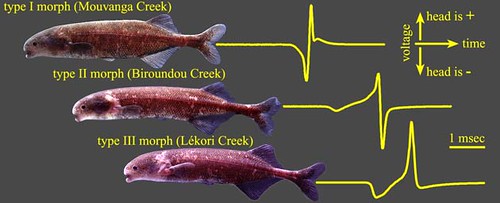
Although these fish look similar and have the same genetic makeup, they
produce very different electrical signals (right) and will only mate with fish that produce
the same signals. Cornell researchers believe that these different electrical signals are the
fishes' first step in diverging into separate species. [Image: Carl Hopkins.]
The fishes depicted in the picture above are several types of mormyrids that are endemic to some tributaries of the Ivindo River in Gabon, Africa. These fishes produce weak electrical signals from a battery-like organ at the base of the tail to communicate with others of their own kind.
Different mormyrid species have differences in their DNA and physical appearances, different communication patterns and they will not interbreed with each other. But in this case, these fishes have communicate using different electrical waveforms (pictured, top) but, curiously, they have identical DNA.
While these fishes may be able to understand other species' impulses, reports Matt Arnegard, a neurobiology postdoctoral researcher at Cornell University, "They seem to only choose to mate with other fish having the same signature waveform as their own."
Because all of the 20 or so mormyrid species have distinct electric signals, Arnegard believes the different waveforms of the fish that he studies might be their first step in diverging into different species.
"We think we are seeing evolution in action," says Arnegard.
There are several ways that speciation occurs. The most familiar results when the same species becomes geographically isolated into two or more groups for many generations, often by a body of water such as on an island. In this situation, over several generations, genetic drift, mutation and differing selective pressures cause the DNA in each group to change such that they diverge into two distinct species. This is known as "allopatric speciation" and is the pattern revealed by the finches on the Galapagos Islands, commonly known as "Darwin's finches."
But speciation can also occur when members of one species consistently refuse to breed with other members of that same species for whatever reason. In the case of these mormyrids, a change in electrical signaling patterns among some members of the same species appears to have occurred, thereby segregating the fishes into separate breeding populations based on their signals alone. After several generations of this reproductive isolation, their DNA will also begin to diverge. However, this pattern of divergence has rarely been documented, so this model, known as "sympatric speciation", is controversial.
"Many scientists claim it's not feasible," Arnegard asserted. "But it could be a detection problem because speciation occurs over so many generations." But because the shapes of mormyrid electrical impulses can change so quickly, Arnegard suspects that this might be a first step in sympatric speciation.
But, Arnegard quickly cautions, "This could be just a polymorphism, like eye color in humans, that violates the fishes' general evolutionary pattern but doesn't give rise to separate species."
Only time, and more research, will tell.
Arnegard returned to Gabon recently to conduct further tests, funded by the National Geographic Society. This research was published in the June issue of the Journal of Experimental Biology, which is STILL not available online yet!
Source
Cornell University press release.
.
- Log in to post comments


while in school I lived for one year in a graduate dorm with biology students as some of my neighbors. One of them lent me a tome on evolution by, I think, Dobzhansky, in which the idea of sympatric speciation was discussed. One means of reproductive isolation in the same location suggested in the book was via a change in flash pattern of fireflies. I went out onto the second-floor balcony of the TV room, which faced a dark woods, and there I spent some time in the late-spring, Tidewater-Virginia evening watching fireflies signal to each other in the woods. There was one that had a rapid flash pattern, around five on-and-offs in a second, that captivated me. It looked like a tiny strobe light in flight. Most of the other fireflies were simply broadcasting a single on-signal for nearly a full second followed by off for a longer interval. It was a worthwhile exercise in observation for me even though I should have had my head down full-time for approaching finals.
Human identical twins have different fingerprint patterns. It is my understanding that this is due to differences in the uterine environment that one fetus experiences vs. the other one.
It seems the fishes are from different creeks (?) Could it be that, like the identical twins, the differences in the makeup of the creek environments (water, minerals, creekbed materials, creek source, etc ) might be modifying organs that are sensitive to such changes and which are also important in mate selection.
It would not be strange to think that organs could be sensitivbe to environment in this way...similar to how Pacific Salmon can find their natal creeks after years at sea...